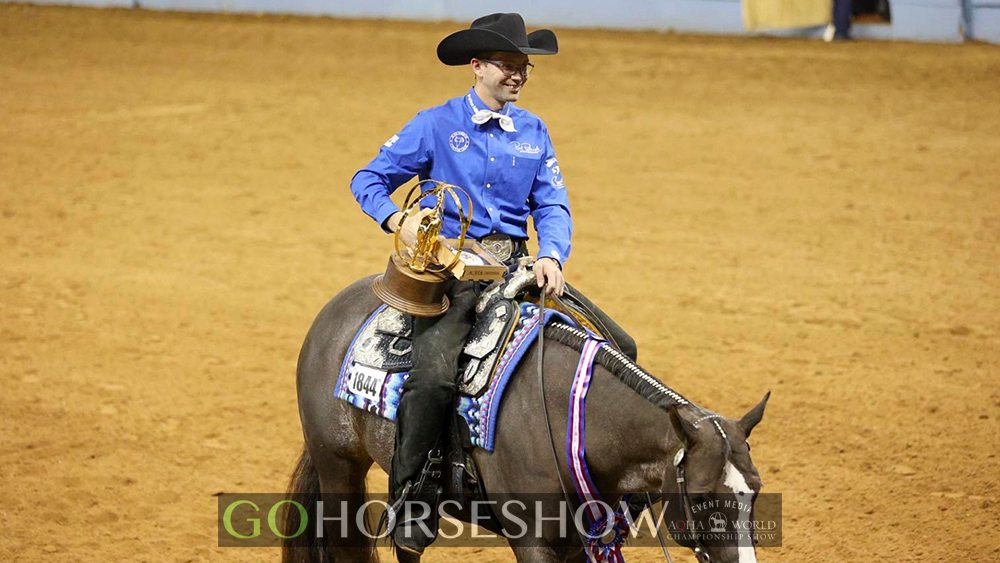If only horses could talk – that would make the whole training and riding process so much easier. They could tell us if they’re sore, bored, frustrated, or if they don’t like their job.
Unfortunately, unlike a C.S. Lewis novel, horses can’t carry on a conversation with us. Instead, we have to rely on paying attention to subtle signs in their behavior and movement to determine their feelings at any given time.
We spoke to multiple World and Congress Champion trainer Aaron Moses to get his perspective on how to incentivize a horse that tries and deal with an uncooperative one.
Build a Horse that Tries
“Perhaps the biggest issue I see with training horses is that many people don’t give the animal a reason to try,” Moses explains. “The best incentive for effort in the horse’s mind is the release. And, unfortunately, the timing of the release can be difficult for many riders to master, which then incentivizes the horse to stop trying.”
 Interval training in exercise is one way to look at incentivizing effort that humans can understand. If you are told that you will have to try your hardest for 15 seconds, it’s easier to put forth the effort because you know the end is in sight.
Interval training in exercise is one way to look at incentivizing effort that humans can understand. If you are told that you will have to try your hardest for 15 seconds, it’s easier to put forth the effort because you know the end is in sight.
However, if your trainer tells you to keep going after you’ve met the 15–second mark, chances are you won’t go all out in the next interval set because you don’t trust the release. In this way, the amount of effort is directly proportionate to the anticipated relief.
Therefore, Moses says that creating a horse that tries is a crucial part of their training when they are young and it all comes down to rewarding the effort and “little victories” with a properly-timed release.
How to Reward the Effort Properly
“If you want to create an animal that wants to try, you need to give them a chance to do it. When your horse responds to your request with effort in the direction of what you are asking for, reward that spot where they are looking for the right answer.”
Moses clarifies, “Gradual rewards are particularly important for young animals or animals learning new skills. In this way, you don’t want to wait until the skill is perfect because you won’t be rewarding the steps of progress and it is more likely the animal will give up and begin fighting with you.”
Aaron gives the example of training the perfect back. “Obviously, you want a horse that backs up straight with little pressure on their face and keeps their neck level. That would be the end goal.”
 “Now, if you have a horse that throws its head and plants its feet when you ask for the back, you will have to know what constitutes progress toward the end goal and reward each step in that direction.”
“Now, if you have a horse that throws its head and plants its feet when you ask for the back, you will have to know what constitutes progress toward the end goal and reward each step in that direction.”
“Therefore, in this example, if the horse leans back without throwing its head and takes a step backwards, that deserves a release. This is your way of telling the horse they are listening and that is what you want. Then with each little progression toward the end, make sure you release. This process will motivate your horse to keep trying and it’s more likely they will get a perfect back sooner than later.”
Questions to Ask Yourself
Moses advises that riders have questions in mind to determine whether the horse is actually trying.
“Always ask yourself first: Does the horse understand? If you are trying something new to them, cut the horse some slack and give them time to learn. If you know the horse is familiar with the concept, you can put a little more pressure on the horse to try harder. Up the pressure and give them more incentive to look for that spot. If they rise to the occasion…release!”
The Horse Has No “Try”
It is a common critique of horses in the industry – they have potential, but they just don’t have any try. Moses believes that this is possible, but it is more likely an issue with training than simply a “bad” individual.
 “I think a lot of the bad behavior we see can be contributed to missing the release,” Moses opines. “When this happens, the horse will start looking for another way out because they’ve tried to do what you asked and it wasn’t enough. This is when we start to see them engaging in bad behaviors to avoid the pressure, like jumping, rearing, leaping, or bolting.”
“I think a lot of the bad behavior we see can be contributed to missing the release,” Moses opines. “When this happens, the horse will start looking for another way out because they’ve tried to do what you asked and it wasn’t enough. This is when we start to see them engaging in bad behaviors to avoid the pressure, like jumping, rearing, leaping, or bolting.”
“Most horses are not born without resistance. Every horse has spots they need to get through. But one of the most important aspects of training is finding the right amount of pressure until the horse finds the right answer and then immediately rewarding that good choice on their part with the release.”
Know Your Horse
Moses reminds us that every horse is different, so there is no formula for what signs indicate that a horse is lazy. Therefore, he believes the best way to get inside the animal’s head is to spend time getting to know them.
 “Knowing the horse is the most important foundation to determining whether the horse is trying. Know their mentality. Have they been tough about everything and they’re just hard-headed? Have they been super easy in the past such that their lack of willingness to try may be indicative of pain? Are they typically a quick learner, or are they slower to get new concepts? Is this a horse that requires a firmer hand, or are they super sensitive to pressure?”
“Knowing the horse is the most important foundation to determining whether the horse is trying. Know their mentality. Have they been tough about everything and they’re just hard-headed? Have they been super easy in the past such that their lack of willingness to try may be indicative of pain? Are they typically a quick learner, or are they slower to get new concepts? Is this a horse that requires a firmer hand, or are they super sensitive to pressure?”
Once you have an idea about the animal’s personality and response to training methods, it can be much easier to gauge when to push them and when to lay off a bit.
Dealing with the Difficult or Lazy Horse
Before you can ask whether your horse is simply being lazy or difficult, it is important to make sure your horse is: (1) sound, (2) not in any pain, and (3) physically capable of performing the task you are asking them to do.

If you can answer affirmatively to all three of those inquiries, then you can begin to investigate whether your horse is trying to get out of work.
“One big sign that an animal is in pain is when something that used to be easy for them is now hard. If the horse used to easily back, and now they’re struggling or it used to be easy to move their hip over and now it’s not, then that is more likely a sign of pain as opposed to being uncooperative,” Moses explains.
“There are some horses that don’t have much try. And some will resist no matter what you ask,” Moses chuckles. “These horses will need a lot more incentive and more push to try to get them to do what they need to do. They ultimately require a lot more patience and acceptance of gradual progress.”
 Moses recommends that these “harder” horses will take some creativity in training. “I will try many ways to approach an issue, asking them in a variety of ways to get the result I want, while rewarding the slow progress.”
Moses recommends that these “harder” horses will take some creativity in training. “I will try many ways to approach an issue, asking them in a variety of ways to get the result I want, while rewarding the slow progress.”
“At the end of the day, you can’t make a horse cooperate. If you are consistently fighting with a horse or unable to make small progress, then it might be time for a different job or a different trainer. Not every rider can bring out the best in a horse and not every horse fits every rider. At least you can say you tried and hopefully find a program or discipline that works better for the animal.”









